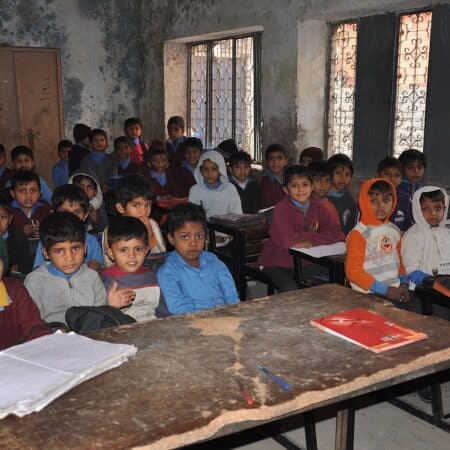
Pakistan Institute of Development Economics
- Home
Our Portals
MenuMenuMenuMenuMenuMenuMenu - ResearchMenuMenuMenuMenuMenuMenuMenu
- Discourse
- The PDR
- Our Researchers
- Academics
- Degree Verification
- Thesis Portal
- Our Portals

Need for Inclusive Education
Introduction
Affirmation of the right to inclusive education is part of an international shift from a “medical model” of viewing disability to a “social model” which recognizes disability as an interaction between individuals and their environment, with an emphasis on identifying and removing discriminatory barriers and attitudes in the environment. According to the Convention on the Rights of the Child (CRC) “the disabled child has effective access to and receives education, training, health care services, rehabilitation services, preparation for employment and recreation opportunities in a manner conducive to the child’s achieving the fullest possible social integration and individual development” (UN, 1989).
According to UNESCO (2010), “Impairments that affect the capacity to communicate and interact in ways common in mainstream schools can impose particularly high practical and social obstacles to participation in education” (p. 182). WHO reported that about one billion of the world population (15%) live with disabilities of which 2-4% experience significant difficulties in functioning. As per World Report on Disability (2011), 80% of these disables live in developing countries. Moreover, at least one in ten is a child.
Children in Pakistan are most vulnerable group
According to the 1998 census, Pakistan has over three million disabled people (2.54% of the population). Out of this disabled population, 0.82 million (24.8%) are of school-going age (between 5-14 years) who are out of school. Their disabilities hinder them from getting their basic rights and live a useful life. Access to inclusive and quality education is one of the basic rights of every child including disabled ones. Different forms of disability such as physical, audio, speech, and illness among children may contribute to dropping out of school due to multiple challenges.
Generally, children in Pakistan are the most vulnerable group facing grave difficulties in their social and economic development. Disabled children (special children) are amongst the most overlooked section of society. Besides disability, factors such as poverty, social stigma, lack of awareness, and inadequate health care add to their plight. The presence of a disabled child in a family affects the socioeconomic standing of the entire family. Households with disabled children generally have lower income and are at higher risk of living in poverty. If born with a disability at a poverty-stricken family, it simply owns more than one disability. In sum, disable children are highly underprivileged in Pakistan. Activists have called for sufficient legislation for children’s rights, but lack of adequate interest renders their calls unattended.[1]

Worrying State of Public Education System
State of the public education system is worrying given that a quarter of the population is less than 16 years. Many children have no access to inclusive education and lack awareness about their rights in the constitution. According to Pakistan Education Statistics (PES-2017), 24.84 million children are out of school, up from 22.63 in 2016. Out of these children, 12.8 million are girls.
How can we achieve Sustainable Development Goal 4- Ensure inclusive and quality education for all? Are our teachers trained in handling a disabled child? DO we have the right and enough ingredients in all functioning schools (e.g. are ramps available in all schools)? Do we have ghost schools in our country? If the answer to any question is “NO” then there is no inclusive education. If someone is accommodating a disabled child in a mainstream school, that is just integration.
Lack of comprehensive data on the status of children with disabilities exacerbates the problem since Pakistan has not conducted a national census for 17/18 years. This lack of data might be due to conceptual ambiguity and inconsistent definitions, issues of stigma in declaring one’s disability, and lack of knowledge about one’s condition, etc. For the reflection of reality, the national census is imperative. There are also no effective policies to address the education needs of every child with a disability in accessing not just education but inclusive and quality education.
Achieving SDG Goal 4
It is therefore of great significance for the government to do the followings in achieving the UN Sustainable Development Goal 4:
- Education systems must take innovative approaches that fit the specific needs of disabled children.
- The government must put implement policies to ensure all children living with disabilities attend school, learn and complete their schooling.
- We need to see designed data collection instruments and programs that take stock of the number of disabled children and persons and elaborate relevant educational programs to include them in schools.
- There needs to be a collection of better quality disaggregated data on disabled children, which can explain the different disabilities and impairments as well as the level of severity. This is imperative for effective planning of inclusion programs, policies, and interventions.
- Pakistan is a signatory to the United Nations Convention on the Rights of Person with Disabilities (UNCRPD) and implementation of the said convention is binding on the Government of Pakistan. Therefore, governments (federal and provincials) need to take appropriate measures to implement the UNCRPD.
[1] Last two figures (1998 census and 6th population and housing census-2017) are significantly low and one of the main reasons is how disability questions are framed in Census and other large-scale surveys
Download full PDF


